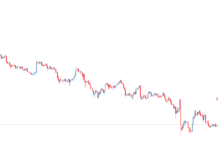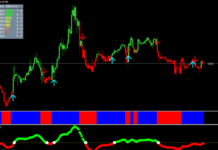The market stays still most of the time and spends only 15-30% of the time creating some trends. Many traders get the largest part their profit from these trend moves. Everyone knows that the best trading system, which has the clear signals that can’t be misinterpreted, that is, the simplest one. Today we are going to discuss the Alligator trend indicator (developed by Bill Williams), which is quite capable of being the main element the trading strategy.
Before reading the article and writing your questions in comments section, I recommend to watch this video. It’s not long, but covers biggest part of questions on the topic.
The Alligator indicator (or the Bill Williams’s Alligator) is a trend indicator, which provides signals that a new trend has begun. It includes a number of the moving averages that use fractal geometry as well as nonlinear dynamics. The indicator is quite popular and included to the analysis set of most terminals. Bill Williams used it in the system “Trading chaos” described in his book “New Trading Dimensions”.
Table of Contents
INDICATOR CHARACTERISTICS
Platform: MetaTrader 4
Currency pairs: Any
Timeframe: Н4 or higher
Trading time: 24-hour
Indicator type: Classic trend indicator
DESCRIPTION
The combination of three Moving Averages is a complex construction, which may be not easy to “read”. Perhaps, that is why many traders cease to work with the MAs hoping to get more information from the indicators, most of which are nothing but a slightly different way of displaying a Moving Average.
This indicator is displayed on the price chart by three Moving Averages having the certain periods and shifts. Trading using the Alligator indicator suits best for the day (or higher) charts. Its peculiarity is that it may theoretically work on any timeframe, which makes it quite universal. However, the practice shows that you shouldn’t go lower the TF or H4 timeframe.
The Alligator indicator got its name because of vague similarity to the crocodile. Its shape reminds an alligator with the closed or opened mouth.

It’s not too complicated to determine the mood and the intentions of the Alligator. Just take a look at three smoothed Moving Averages we have just discussed. The longest one (the balance line) is called the Alligator’s Jaw. Mark this line in blue. A faster Moving Average (8-period with a shift of 5 bars to the future) is the Alligator’s Teeth marked in red. The shortest one is called the Alligator’s Lips and it will be marked in green. These three lines together perfectly show the character of the Alligator and also determine all his current actions and plans for the future.
When the Alligator is sated, it does not care anymore what happens on the market. It is sleeping. At this time, the Moving Averages show its complete indifference to the market. All three lines are inter-crossing at this moment so tightly that it is often difficult to distinguish between them and determine the direction of the following bars. When the Alligator is “sleeping” the market has the range or a sideways trend.
But after a while, the Alligator gets hungry again and awakens from sleep. What do you do when you wake up? I don’t think you just get up and run somewhere. The alligator starts to “yawn” and this immediately affects the nature of interacting of the moving averages. The oscillations amplitude becomes wider so the space between the lines widens slightly. At that moment, you should expect a fractal to appear indicating where the Alligator is going to “crawl searching for food”. As soon as the fractal appears, you should get ready for trading along with the indicator. So after the Alligator yawns, it finally wakes up and goes hunting.
The question is to determine how hungry the Alligator is. That’s very simple! As soon as it starts to hunt, the Jaw opens (the blue line), exposing the Teeth (red line) and leaving the Lips (the green line) closest to the price bars. In other words, all three lines are in the order usual for the trend. The line with the longest period (13) is most far from the price bars. The 8–period line is between the 13-period and the 5-period lines, and the last of them is the closest to the bars.
When the Alligator is hungry, its Jaw opens wider and wider, which shows that it is willing to “eat”. That’s a clear signal of a trend. You can judge about the trend’s end only when the jaw begins to close, that is, the Alligator is going to stop hunting. Sometimes it may only mean only a temporary respite: the Alligator can wake up again at any time with a fine appetite.
Pay attention that crossing the Alligator’s lines is the first signal of the upcoming move in one direction or another. If all three lines are crossed, you can be sure that it is an additional signal after which the “jaw” is supposed to open.
- The blue line (Alligator’s Jaw) is the Balance Line for the period used to create the chart (the 13-period smoothed Moving Average shifted by 8 bars to the future);
- The red line (Alligator’s teeth) is the Balance Line for the significant period of a lower order (the 8-period smoothed Moving Average shifted by 5 bars to the future);
- The green line (Alligator’s Lips) is the Balance Line for a significant period, which is lower by another order (the 5-period smoothed Moving Average shifted by 3 bars to the future).
The Lips, Teeth and Jaw of the Alligator show interaction of different periods. Since you can see the trends on the market only 15-30% of the time, you should follow the trends and avoid trading on the markets changing only within the certain price periods.
When the Jaw, Teeth and Lips are shut or intertwined, the Alligator is going to sleep or is sleeping already. When it sleeps, it gets hungry, and the longer it sleeps, the hungrier it will be on waking up. When it wakes up, the first thing he does is opening the mouth and yawning. Then it begin to smell the food: the bull’s or the bear’s “meat”. So now, the hunt begins. When the Alligator “loads up”, it loses interest in the food (the price). The Balance Lines converge and that’s the time to lock the profit.
CALCULATIONS
MEDIAN PRICE = (HIGH + LOW) / 2
ALLIGATORS JAW = SMMA (MEDIAN PRICE, 13, 8)
ALLIGATORS TEETH = SMMA (MEDIAN PRICE, 8, 5)
ALLIGATORS LIPS = SMMA (MEDIAN PRICE, 5, 3)
at which:
MEDIAN PRICE — median price.
HIGH — maximum bar price.
LOW — minimum bar price.
SMMA (A, B, C) —smoothed MA. The А parameter — smoothed data, the В period — smoothing period, the С period — shift to the future. For example, the SMMA (MEDIAN PRICE, 5, 3) means that the smoothed MA is taken from the median price and the smoothing period is 5 and the shift is 3.
ALLIGATORS JAW — Blue line.
ALLIGATORS TEETH — Red line.
ALLIGATORS LIPS — Green line.
The “Alligator Jaw” shows us the prices that will be set on the market if some new factors do not affect them. If the price is above this line, the market will not only move up but also positively evaluate new factors. Consequently, if the price is below the “jaw”, the market will go down and take the new factors negatively.
HOW TO USE ALLIGATOR INDICATOR
Determining the trend’s strength
In order to determine the strength of the market movement, you need to analyze how long the Moving Averages have been crossing. The longer the indicator lines in this position, the greater the chances of a strong trend movement to come soon.

Opening the Position

The Alligator indicator also provides signals to open the positions. If the moving averages’ amplitude starts to enlarge during the trade and the distance between them gradually grows, then it is a signal that a new trend begins. Its direction will show the appeared fractal, when the candle closes completely above all three moving average indicators. After this fractal appears, you can start trading. Open long only when the Alligator’s lines start to move up, and are below the fractal directed upwards (the closed bullish candle), and is above the green line.
To open short, you should get a signal that the fractal is below all the lines, and is directed downwards completely (a closed bearish candle) and is below the lips of the Alligator (the green MA).
Usually the traders don’t use the Alligator indicator on its own (just like any other indicator) to enter the market. You need confirmation in the form of a fractal directed upwards or one more signal received from another indicator (for example, the Stochastic indicator).
Stop Loss Order

We advise to take a look at the blue indicator line to set a Stop Loss order while opening a position.
Trend Filter
The traders also use the signals of the Alligator indicator to determine the trend. If the blue Moving Average is the furthest one from the price bars, the red line between 13- and 5-period MAs, and the green line is the closest one to the price chart, then you can be sure that there is (or only begins) a trend on the market. If the price is higher than three lines, you are seeing an uptrend and vice versa.
Closing the Positions
You may be figuring out how to choose the right moment to leave the market with the maximum profit using the Alligator. You should use best any system based on the use of Trailing Stop orders. For example, you can focus on the Teeth line, which is an 8-period smoothed MA shifted by 5 bars to the future. You can also use the Parabolic SAR indicator, which draws the points above or below the price in dependence to the current trend. If you prefer working on the high periods (H4 and higher), then you might use trailing by the candles’ shadows, extremums or fractals.
INDICATOR DRAWBACKS
The Alligator indicator has several drawbacks just like any other indicator.
- First, it works out the signals a bit late. It requires a formed trend on the market to create them.
- Second, the Forex Alligator creates a lot of false signals on the flat market (especially while crossing the lines). If you want it to react more or less accurately to the signals, you should use additional filters (for example the RSI, which also generates signals for the movement and pullback of the currency pair).
CONCLUSION
Today we have discussed how to apply the classic trend Alligator indicator in the trade. If you are a fan of the trend trading systems, you should definitely try the Alligator in your strategy. Perhaps this is exactly what you have been waiting for so long.






Good tutorial. Thank you 🙂
As always great advice, clear and well presented. Thank You.
I have studied few of your articles recently, frankly they really make sense and straight to the point. I appreciate you and you are awesome in your training style.
I have studied few of your articles recently, frankly they really make sense and straight to the point. I appreciate you and you are awesome in your training style.
U r the man! Best explanation of how to use the Alligator
Sir, will really like to keep in touch. How can i contact you?
Sir , it’s really great., I really love your work. It is understandable and you made it simple , Thank you Sir.
Hello Sir, how are you? I’m a fan of you and I enjoy your tutorials thanks so much for giving us a fraction of your knowledge
Sir can you do a video on money management for us to learn please
What are your best alligator settings for newbies like me?